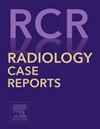伴囊性脑软化进化的免疫正常宿主巨细胞病毒脑膜脑炎
Q4 Medicine
引用次数: 0
摘要
先前健康的2个月大男性出现发烧和癫痫。脑脊液(CSF)检查、头部计算机断层扫描(CT)和脑磁共振成像(MRI)检查在入院时无显著差异。入院第二天因脑水肿出现临床症状下降,复查头部CT显示灰质白质分化丧失,提示全局性缺氧损伤。重复脑部MRI在5天发现扩散限制全球扩散,急性梗死后下小脑动脉领土,和左frontoparietal软脑膜炎和皮质层状坏死。第5天进行重复LP,显示有核细胞总数为42个/mm^3,其中淋巴细胞39%,单核细胞61%,葡萄糖52 mg/dL。在支持性护理下,他的临床状况稳步改善。在第11天用PCR检测到重复脑脊液样本中的巨细胞病毒,并开始使用更昔洛韦治疗巨细胞病毒脑膜脑炎。即使在免疫功能正常的患者中,巨细胞病毒也应被视为病毒性脑膜脑炎的病因。我们的病例也显示了巨细胞病毒脑膜脑炎的典型影像学演变。本文章由计算机程序翻译,如有差异,请以英文原文为准。
Cytomegalovirus meningoencephalitis in an immunocompetent host with evolution of cystic encephalomalacia
A previously healthy 2-month-old male presented with fever and seizures. Cerebrospinal fluid (CSF) studies, head computed tomography (CT), and brain magnetic resonance imaging (MRI) studies were unremarkable on admission. After a clinical decline on the second day admission due to cerebral edema a repeat head CT showed loss of gray-white matter differentiation indicative of global anoxic injury. A repeat brain MRI on day 5 revealed diffuse restricted diffusion globally, acute infarction of the right posterior inferior cerebellar artery territory, and left frontoparietal leptomeningitis versus cortical laminar necrosis. A repeat LP was done on day 5 and showed a total nucleated cell count of 42 cells/mm^3 with 39% lymphocytes and 61% monocytes, glucose 52 mg/dL. He made steady clinical improvement with supportive care. CMV was detected on the repeat CSF sample using PCR on day 11 and he was started on ganciclovir for CMV meningoencephalitis. CMV should be considered as an etiology for viral meningoencephalitis even in immunocompetent patients. Our case also shows the classic imaging evolution of CMV meningoencephalitis.
求助全文
通过发布文献求助,成功后即可免费获取论文全文。
去求助
来源期刊

Radiology Case Reports
Medicine-Radiology, Nuclear Medicine and Imaging
CiteScore
1.10
自引率
0.00%
发文量
1074
审稿时长
30 days
期刊介绍:
The content of this journal is exclusively case reports that feature diagnostic imaging. Categories in which case reports can be placed include the musculoskeletal system, spine, central nervous system, head and neck, cardiovascular, chest, gastrointestinal, genitourinary, multisystem, pediatric, emergency, women''s imaging, oncologic, normal variants, medical devices, foreign bodies, interventional radiology, nuclear medicine, molecular imaging, ultrasonography, imaging artifacts, forensic, anthropological, and medical-legal. Articles must be well-documented and include a review of the appropriate literature.
 求助内容:
求助内容: 应助结果提醒方式:
应助结果提醒方式:


